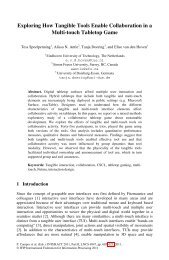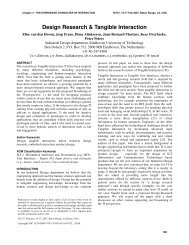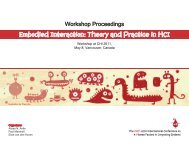Sissy - Elise van den Hoven
Sissy - Elise van den Hoven
Sissy - Elise van den Hoven
You also want an ePaper? Increase the reach of your titles
YUMPU automatically turns print PDFs into web optimized ePapers that Google loves.
Jeni Paay, Jesper Kjeldskov, Mikael Skov<br />
Aalborg University<br />
Selma Lagerlöfs Vej 300<br />
DK-9220 Aalborg, Denmark<br />
(jeni, jesper, dubois)@cs.aau.dk<br />
ABSTRACT<br />
Cooking together is an important part of everyday life. In<br />
cooking with others we share not only the experience of<br />
creating the meal, but a social event in which people<br />
enhance their relationships through shared stories,<br />
relating daily happenings and discovering new ideas<br />
about food preparation from each other. Cooking together<br />
in the kitchen also involves bodily negotiation, where we<br />
position ourselves in order to share techniques, show<br />
progress in cooking, demonstrate what the food should<br />
look like at many points in the recipe, and share the<br />
sociality of the activity. If we then want to introduce<br />
technology into this situation, to support either the<br />
cooking activity, the social activity or both, it is important<br />
that we design this technology to fit with the physicality<br />
of both the kitchen, and the cooks. Our method for<br />
understanding the bodily experience of the cooking<br />
activity involved a digital ethnography on a set of<br />
YouTube videos of people cooking together in their<br />
kitchens. From an analysis of F-formations of social<br />
encounters in the kitchen, we were able to i<strong>den</strong>tify the<br />
“spooning” configuration – a close-up view over the<br />
cooks shoulder as an important part of the human-food<br />
interaction.<br />
Author Keywords<br />
Cooking together, the body in the kitchen.<br />
ACM Classification Keywords<br />
H5.m. Information interfaces and presentation (e.g.,<br />
HCI): Miscellaneous.<br />
INTRODUCTION<br />
Cooking together is an important part of our lives. We<br />
cook with friends, families, colleagues and strangers to<br />
share not only the experience of creating a meal, but as a<br />
social event where we enhance our relationships with<br />
others through shared stories, relating daily happenings<br />
and discovering new ideas about food preparation from<br />
each other. Recently, the kitchen has become a focus for<br />
HCI research into understanding the role that technology<br />
currently plays with regard to the cooking activity and<br />
what roles it might play in the future (Grimes & Harper,<br />
2008).<br />
From a methodological point of view, we want to<br />
OZCHI 2011, Nov 28 – Dec 2, 2011, Canberra, Australia.<br />
Copyright the author(s)<br />
Available online at<br />
http://research.it.uts.edu.au/idhup/workshops/workshop-the-body-indesign/<br />
OZCHI 2011 Workshop Proceedings The Body In Design<br />
ISBN: 978-0-9757948-5-2<br />
Spooning in the Kitchen<br />
30<br />
Kenton O’Hara<br />
Microsoft Research<br />
7 J J Thompson Ave<br />
Cambridge CB3 0FB, UK<br />
oharakenton@gmail.com<br />
understand the shared cooking experience for the purpose<br />
of generating design ideas for technological augmentation<br />
of kitchen spaces. This involves understanding not only<br />
how artefacts and kitchen spaces shape the movements of<br />
an individual while cooking, but also how the presence of<br />
others, sharing the cooking experience, influence the<br />
kinds of physical interactions that happen. In using<br />
YouTube as our data source, we are able to focus on<br />
peoples interactions with co-present others, with physical<br />
space, with cooking artefacts, as well as the remote<br />
audience (via the camera).<br />
Our first research agenda is to gather understanding of the<br />
human-food interaction to inform technology and<br />
interaction design providing people with the experience<br />
of cooking with family, friends and others who are<br />
geographically distributed using their respective kitchens<br />
as a single, digitally “blended” cooking space. Our<br />
manifesto is that people involved in this shared remote<br />
cooking activity should experience essential, “as if I was<br />
there”, aspects of the cooking activity. This then supports<br />
distant friends and relatives sharing their everyday<br />
activities, using the cooking activity to set the<br />
conversational context, with close ones who are living<br />
away. This is important for maintaining these close tie<br />
relationships (Nardi et al, 2004).<br />
BACKGROUND<br />
Inspired by smart domestic environment projects (e.g.<br />
Georgia Tech Aware Home 1 , MIT House_n 2 , Washington<br />
State University CASAS Smart Home 3 ) and in particular<br />
smart kitchen projects (e.g. CounterIntelligence 4 ,<br />
CounterActive 5 ), especially collaborative cook (deRuna<br />
et al., 2010), our design focus is on adding value to a<br />
shared domestic experience, using technology to bring<br />
people together in a social context. We take the approach<br />
that kitchens are “sites where meaning is produced, as<br />
well as meals” (Bell & Kaye, 2002) to create a blended<br />
interactive kitchen space for geographically distributed<br />
people together in a shared virtual place for socializing<br />
while cooking.<br />
An important challenge for HCI researchers interested in<br />
the design of new domestic technologies is to observe and<br />
1 http://awarehome.imtc.gatech.edu/<br />
2 http://architecture.mit.edu/house_n/<br />
3 http://architecture.mit.edu/house_n/<br />
4 http://www.media.mit.edu/ci/<br />
5 http://www.media.mit.edu/pia/counteractive/



![Download 1.8 MB [pdf] - Elise van den Hoven](https://img.yumpu.com/18078175/1/190x245/download-18-mb-pdf-elise-van-den-hoven.jpg?quality=85)

![Download 0.2 MB [pdf] - Elise van den Hoven](https://img.yumpu.com/18078145/1/182x260/download-02-mb-pdf-elise-van-den-hoven.jpg?quality=85)
![Download 0.1 MB [pdf] - Elise van den Hoven](https://img.yumpu.com/18078125/1/190x146/download-01-mb-pdf-elise-van-den-hoven.jpg?quality=85)
![Download 1.9 MB [pdf] - Elise van den Hoven](https://img.yumpu.com/18078041/1/182x260/download-19-mb-pdf-elise-van-den-hoven.jpg?quality=85)

